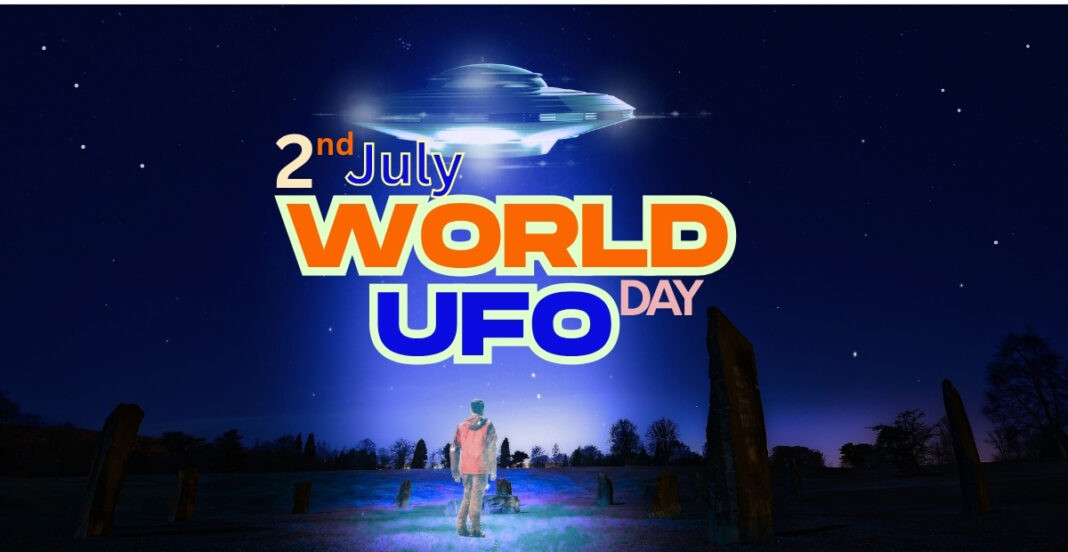Every year on July 2, people across the globe pause for World UFO Day. The date stirs excitement, raises questions, and encourages speculation about life beyond Earth. Whether a skeptic or a true believer, anyone drawn to the unexplained can use this occasion to glance-up and imagine.
What Is World UFO Day?
World UFO Day is a worldwide effort devoted to unidentified flying objects. The observance highlights reports of strange aerial phenomena, ongoing space puzzles, and the long search for intelligent neighbours. At heart, it invites discussion of glowing orbs, classic flying saucers, and the possibility that Earth is one voice in a cosmic choir.
Why July 2?
Supporters chose July 2 because it coincides with the famous Roswell Incident of 1947. On that day an unusual crash site appeared near Roswell, New Mexico, USA, feeding popular speculation. Official explanations blamed a weather balloon, while many locals pointed to an alien craft. The debate launched decades of fascination, so July 2 now serves as the unofficial anniversary for all things extraterrestrial.
What Are UFOs?
The term UFO, or Unidentified Flying Object, simply refers to any aerial phenomenon that observers cannot identify at the moment of sighting. While the vast majority of these reports later turn out to be aircraft, satellites, or natural atmospheric events, a small proportion persists as unexplained.
Witnesses from diverse regions have recounted experiences involving:
- Pulsing or darting lights
- Unusual, non-conventional craft shapes
- Silent, rapidly traversing objects
- Possible interactions with extraterrestrial beings
For many individuals, such accounts hint at intelligent life beyond Earth.
The Purpose of World UFO Day
World UFO Day is about more than flashy stories of flying saucers. Its real aim is to inspire citizens to
- keep looking up and nurturing curiosity.
- share and discuss their own sightings without fear.
- press authorities for open facts on unexplained aerial phenomena.
- engage with science and space through playful, creative activities.
The observance invites everyone to ponder the larger questions: What, if anything, floats beyond Earth? Are we genuinely alone? Should we search for contact .
How People Celebrate World UFO Day
Around the planet, lovers of the unknown mark World UFO Day with imaginative and meaningful traditions. Here are some popular ideas:
1. Stargazing Events
Families, friends, and clubs spread blankets in parks, backyards, or rooftops to scan the heavens. Many join spirited stargazing parties, equipped with telescopes, smart apps, and shared snacks.
2. Watch UFO Documentaries
Cable channels and streaming platforms ready marathons of films, shows, and docuseries exploring strange lights, alleged abductions, and the mysteries of deep space.
3. UFO Festivals
Cities like Roswell throw vibrant UFO-themed festivals featuring colorful parades, homemade costumes, lively lectures, alien art stalls, and, of course, plenty of green lanterns. It blends entertainment with serious inquiry.
4. Share Stories
Online forums are now packed with personal UFO stories. Users post everything from photographs and shaky cellphone videos to full-scale alien memes.
5. Creative Crafts and Costumes
Household craft tables buzz as children and adults alike glue foil antennae, dab paint on cardboard planets, and slip into homemade extraterrestrial outfits.
Famous UFO Sightings
A handful of classic cases still spark debate, each leaving its own riddle:
- Roswell Incident (1947)– the gold standard for flying-saucer lore.
- Phoenix Lights (1997)– thousands of Arizonans watched enormous orbs drift overhead.
- Rendlesham Forest (1980)– U.S. personnel in England reported odd glowing craft in the woods.
- Tic Tac UFO (2004)– Navy cockpit footage shows an object darting at impossible speed.
These encounters remain officially unexplained and keep the search alive.
Is There Science Behind UFOs?
Absolutely. Though most sightings turn out to be weather balloons or drones, astronomers and space agencies still study the odd ones. NASA, the Pentagon, and independent teams now use the label “unidentified aerial phenomena,” or UAP.
Why World UFO Day Matters
World UFO Day matters because it:
- Encourages critical thinking about what we see
- Inspires young minds to study space and science
- Brings people together from all countries and beliefs
- Promotes open discussion without fear of judgment
It celebrates curiosity, imagination, and the endless possibilities of the night sky.
How You Can Join In
You don’t need a telescope or a spaceship to join World UFO Day. Try one of these:
| Activity | Description |
|---|---|
| Watch the sky | Look for moving lights or shapes |
| Share a UFO story | Post online or tell a friend |
| Read about space | Learn how planets and stars work |
| Make alien crafts | Get creative with your kids |
| Host a movie night | Watch a sci-fi film with popcorn |
Fun Facts About UFOs
- Over half of Americans believe in the possibility of aliens.
- In 2020, the Pentagon released real UFO videos from U.S. Navy pilots.
- UFOs are now called UAPs (Unidentified Aerial Phenomena) in many reports.
- Many recent reports ultimately turn out to be drones, atmospheric phenomena, or satellite traffic.
- Even in antiquity, cultures expressed curiosity about the skies through visual art and oral myths featuring unusual aerial figures.
Final Thoughts
World UFO Day invites the curious to pause, reflect, and pursue a question that has no clear endpoint. Whether you scan celestial maps, browse folk legends, or simply tilt your head toward the night, the date urges all of us to keep the spirit of exploration alive.
So on July 2, spread out a blanket, summon a friend, and allow the dark canvas above to stir your imagination.
Are we the single intelligent species in a vast cosmos? Perhaps; perhaps not. That uncertainty, familiar to scientists and enthusiasts alike, gives World UFO Day its particular charge.


